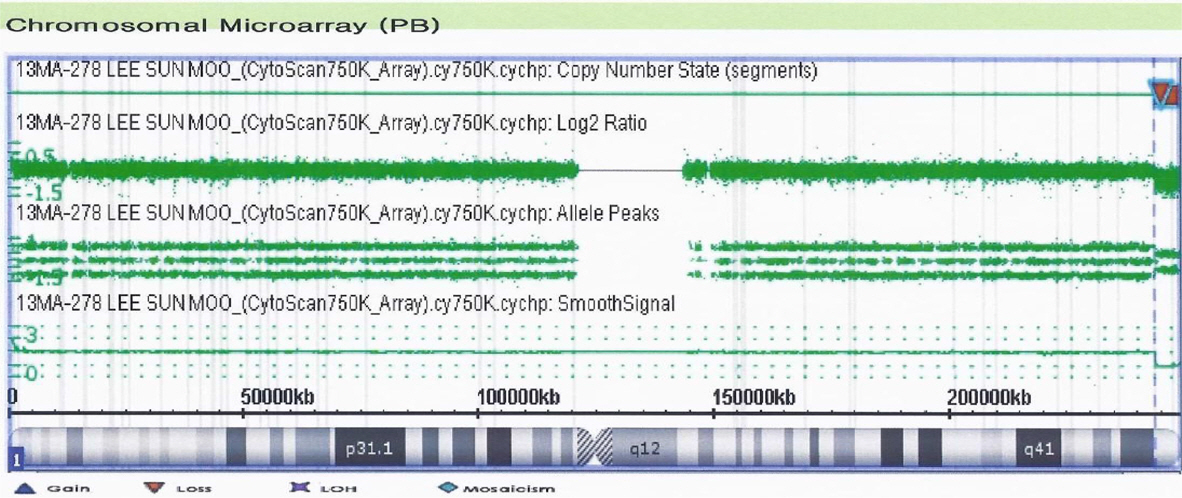Korean J Perinatol.
2014 Jun;25(2):95-99. 10.14734/kjp.2014.25.2.95.
A Case of Chromosome 1q44 Deletion with Microcephaly and Multiple Congenital Anomalies
- Affiliations
-
- 1Department of Pediatrics, Busan Paik Hospital, Inje University College of Medicine, Busan, Korea. iamgawon@hanmail.net
- KMID: 2280960
- DOI: http://doi.org/10.14734/kjp.2014.25.2.95
Abstract
- The 1q terminal deletion syndrome is a rare chromosomal disorder which was first reported by Mankinen et al. in 1976. This disorder has shown to have broad and diverse clinical phenotypes. Specific phenotypes of 1q terminal deletion syndrome include microcephaly, seizures, psychomotor retardation, growth retardation, abnormalities of extremities, corpus callosum, heart and genitalia. Although this disorder has diverse clinical manifestations, almost all cases of 1q44 deletion syndrome have growth, psychomotor, and mental retardation and progressive microcephaly. The first diagnosis of 1q44 deletion syndrome in Korea was made by fluorescent in situ hybridization analysis in a 4-month-old girl with craniofacial anomalies, multiple congenital anomalies, and growth and psychomotor retardation. We report the second domestic case of 1q44 deletion syndrome with cleft palate, facial dysmorphism, single umbilical artery, foot abnormality, progressive microcephaly, growth and psychomotor retardation which was confirmed by microarray for comparative genomic hybridization. We also compare this case with previously reported cases of 1q44 deletion syndrome.
Keyword
MeSH Terms
-
Chromosome Disorders
Chromosomes, Human, Pair 1
Cleft Palate
Comparative Genomic Hybridization
Corpus Callosum
Developmental Disabilities
Diagnosis
Extremities
Female
Foot
Genitalia
Heart
Humans
In Situ Hybridization, Fluorescence
Infant
Intellectual Disability
Korea
Microcephaly*
Oligonucleotide Array Sequence Analysis
Phenotype
Seizures
Single Umbilical Artery
Figure
Reference
-
1.Mankinen CB., Sears JW., Alvarez VR. Terminal (1)(q43) long-arm deletion of chromosome no. 1 in a three-year-old female. Birth Defects Orig Artic Ser. 1976. 12:131–6.2.van Bever Y., Rooms L., Laridon A., Reyniers E., van Luijk R., Scheers S, et al. Clinical report of a pure subtelomeric 1qter deletion in a boy with mental retardation and multiple anomalies adds further evidence for a specific phenotype. Am J Med Genet A. 2005. 135:91–5.
Article3.De Vries BB., Knight SJ., Homfray T., Smithson SF., Flint J., Winter RM. Submicroscopic subtelomeric 1qter deletions: a recognisable phenotype? J Med Genet. 2001. 38:175–8.
Article4.Cho JH., Song ES., Kim HN., Oh BS., Choi YY. A case of chro- mosome 1q44 deletion: the first report in Korea. Korean J Pediatr. 2014. 57:292–6.5.Hill AD., Chang BS., Hill RS., Garraway LA., Bodell A., Sellers WR, et al. A 2-Mb critical region implicated in the microcephaly associated with terminal 1q deletion syndrome. Am J Med Genet A. 2007. 143A:1692–8.
Article6.Boland E., Clayton-Smith J., Woo VG., McKee S., Manson FD., Medne L, et al. Mapping of deletion and translocation breakpoints in 1q44 implicates the serine/threonine kinase AKT3 in postnatal microcephaly and agenesis of the corpus callosum. Am J Hum Genet. 2007. 81:292–303.
Article7.van Bon BW., Koolen DA., Borgatti R., Magee A., Garcia-Minaur S., Rooms L, et al. Clinical and molecular characteristics of 1qter microdeletion syndrome: delineating a critical region for corpus callosum agenesis/hypogenesis. J Med Genet. 2008. 45:346–54.
Article8.Poot M., Kroes HY., V D Wijst SE., Eleveld MJ., Rooms L., Nievelstein RA, et al. Dandy-Walker complex in a boy with a 5 Mb deletion of region 1q44 due to a paternal t(1;20)(q44; q13.33). Am J Med Genet A. 2007. 143A:1038–44.9.Caliebe A., Kroes HY., van der Smagt JJ., Martin-Subero JI., Tönnies H., van 't Slot R, et al. Four patients with speech delay, seizures and variable corpus callosum thickness sharing a 0.440 Mb deletion in region 1q44 containing the HNRPU gene. Eur J Med Genet. 2010. 53:179–85.10.Ballif BC., Rosenfeld JA., Traylor R., Theisen A., Bader PI., Ladda RL, et al. High-resolution array CGH defines critical regions and candidate genes for microcephaly, abnormalities of the corpus callosum, and seizure phenotypes in patients with microdeletions of 1q43q44. Hum Genet. 2012. 131:145–56.
Article11.Orellana C., Roselló M., Monfort S., Oltra S., Quiroga R., Ferrer I, et al. Corpus callosum abnormalities and the controversy about the candidate genes located in 1q44. Cytogenet Genome Res. 2009. 127:5–8.
Article12.Thierry G., Bénéteau C., Pichon O., Flori E., Isidor B., Popelard F, et al. Molecular characterization of 1q44 microdeletion in 11 patients reveals three candidate genes for intellectual disability and seizures. Am J Med Genet A. 2012. 158A:1633–40.
Article13.Lossi AM., Laugier-Anfossi F., Depetris D., Gecz J., Gedeon A., Kooy F, et al. Abnormal expression of the KLF8 (ZNF741) gene in a female patient with an X; autosome translocation t(X;21)(p11.2;q22.3) and non-syndromic mental retardation. J Med Genet. 2002. 39:113–7.14.Shoichet SA., Hoffmann K., Menzel C., Trautmann U., Moser B., Hoeltzenbein M, et al. Mutations in the ZNF41 gene are associated with cognitive deficits: identification of a new candidate for X-linked mental retardation. Am J Hum Genet. 2003. 73:1341–54.
Article15.Hiraki Y., Okamoto N., Ida T., Nakata Y., Kamada M., Kanemura Y, et al. Two new cases of pure 1q terminal deletion presenting with brain malformations. Am J Med Genet A. 2008. 146A:1241–7.
Article
- Full Text Links
- Actions
-
Cited
- CITED
-
- Close
- Share
- Similar articles
-
- A chromosome 1q44 deletion in a 4-month-old girl; The first report in Korea
- Chromosome 7q Deletion Syndrome [46, XX, del(7)(q34)] with Hydronephrosis
- A Case of Del 13(q24) Syndrome with Multiple Anomalies
- Terminal Deletion of the Chromosome 4q with Hemivertebra: Case Report
- A Case of Partial Long Arm Deletion in Chromosome 2 with Multiple Anomalies



